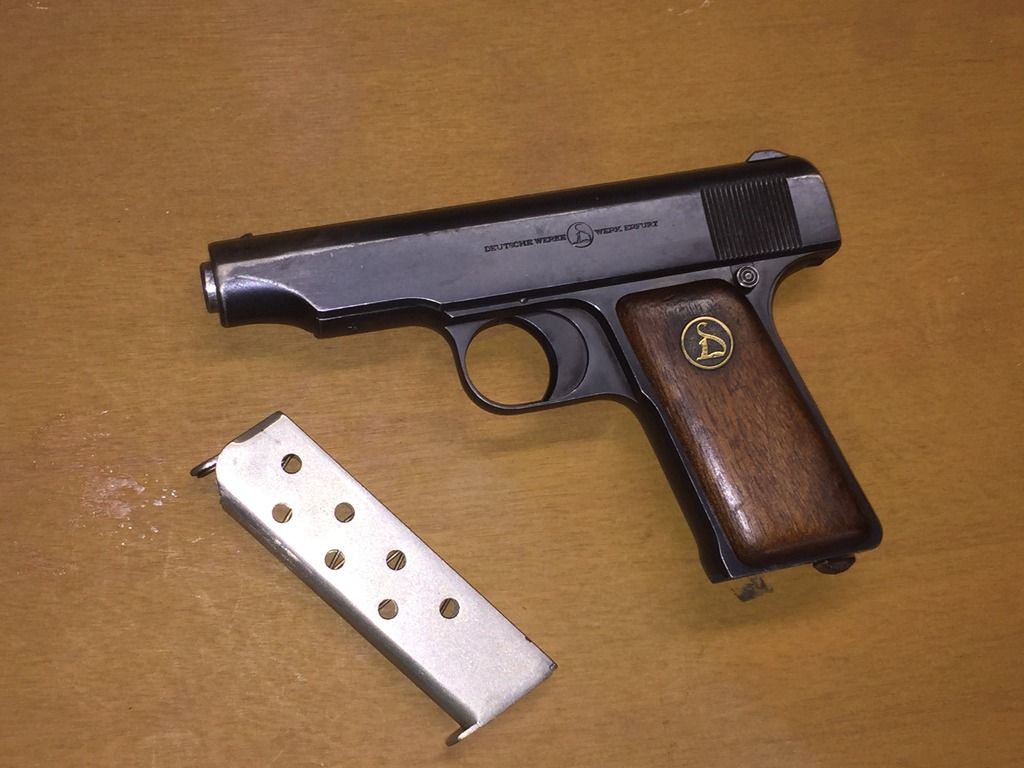
Description: Ortgies 7.65 Pistol manufactured by Deutsche Werke Erfurt. Serial number 59166, 3.4 inch barrel, Eight round magazine capacity. Marked Germany for export. Unique design in that the gun has no screws holding it together. Manufacture started in Berlin in 1918 moved to Erfurt in 1922 and production ceased in 1929. Patented c1916 by Heinrich Ortigies, made by Deutsche-Werke. Built by 'Deutsche Werke Werk Erfurt ', Germany. Serial Number 262632.
Ortgies 7.65 mm semi-automatic pistol with grip safety engaged Type Semi-automatic pistol Place of origin Weimar Republic Production history Designer Heinrich Ortgies Manufacturer Ortgies & Co. Produced 1919 – 1924 Variants 2 Specifications • • • Feed system box magazine The Ortgies 7.65 mm pistol was a produced in Germany in the years immediately after, first by its inventor and then. Inexpensive, but of good quality, the pistol achieved considerable success at contemporary and, as an export product, was popular throughout the. Ortgies cutaway diagram The pistol was produced in,, and variants. Although not expensive, at the time it was of advanced design and high quality construction with relatively few parts, well sealed against dirt. Metal components were or, and assembly in general made no use of, even securing the wooden grips with metal clips, although some examples do incorporate a single screw for that purpose.
The hammerless action depended on a spring-loaded to fire the. As in early and, the Ortgies striker also operated as an ejector as the traveled backwards after discharge. Unusual design features included the and the. The safety was a lever inset into the back of the grip and, with the gun cocked, forced backward out of the grip into the 'safe' position by spring tension from the firing pin upon depression of a button under the slide.
Thus, engaging the safety simultaneously reduced tension on the firing pin spring. To disengage the safety, a shooter simply would squeeze the grip, pressing the lever forward and locking it flush with the back of the frame. At least the earlier Ortgies magazines could accommodate both 7.65mm (aka.32 ACP) and 9 mm Kurz, (aka.380 ACP) ammunition and were interchangeable between pistols of either calibre. One side of the magazine was marked for 7.65 mm and featured seven holes showing the positions that cartridges of that size would occupy when loaded; the other side had similar holes and markings for 9 mm cartridges.
Modern replacement magazines are purpose-built for one caliber only. Production [ ]. Ortgies-Pistols 1921–1924 Heinrich Ortgies designed the pistol while living in during World War I. After the war, he moved to, Germany, where in 1919 he commenced production of the pistol in his own factory. The weapons bore the mark 'Ortgies & Co. – Erfurt' on their slides and a circular brass insert in their grips marked with a stylized 'HO.'
Ortgies died later that year, and eventually production of his pistol passed to, a shipbuilding company headquartered in. For a short time thereafter, the slide marking was changed to 'Deutsche Werke Aktiengesellschaft Berlin' before changing again to 'Deutsche Werke Aktiengesellschaft Werke Erfurt,' ultimately shortened to 'Deutsche Werke – Werke Erfurt.' Deutsche Werke pistols continued to feature the 'HO' brass grip inset until relatively late in their production, when they substituted one with a new trademark depicting a stylized crouching cat with long tail forming an S-curve over its back. In keeping with prevalent economics in Germany at the time, factory finishes were limited to or, rarely, nickel. Skachatj karti dlya batelfild 2 dlya odinochnoj igri torrentom.
The latter finish could be either matte or bright. No Ortgies pistol was produced with a chrome finish or, aside from one known salesman's sample, with factory engraving. Production ceased in 1924.